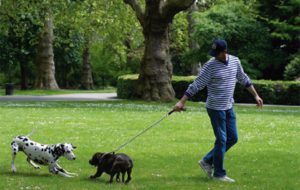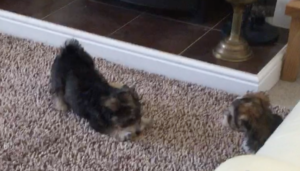Appeasement Behaviour In Dogs – can you spot them?

This post is about appeasement behaviour in dogs. Dogs are communicating all the time. If you watch them carefully, you can actually pick out certain behaviours between dogs. A good example is one dog’s approach to another.
Meeting a new dog
Our dog Jazz is very sociable but he is also very careful when approaching a strange dog in the park. He gets so far then stops a few yards away. He often gives a little bark which is an introduction. Many owners consider it to be a possible act of aggression, but it never is with Jazz. He will often look to one side, sniff the ground and make his way towards the dog in a curved path. approaching from the side.
Communicating friendly behaviour
This behaviour is to assure the strange dog that Jazz means no harm and wants to be friends. Sometimes Jazz will get closer to the dog and if he perceives it to be of no threat (Jazz will have observed the dog’s body posture by now), he will give a play bow. This is when the dog puts his head low to the ground and sticks his behind in the air. It is often partnered with a couple of chirpy barks to incite play, along with a couple of bounces on the front paws to encourage the other dog to join in.
Nervous owners

Unfortunately, owners often do not understand what Jazz is saying and pull their dog away to avoid a ‘situation’. Sometimes they even pick their dog up as if to protect him from the ‘vicious’ dog bouncing in front of them. If only we took more time to understand our canine friends’ language, our walks would be so much more enjoyable. There would be much more interaction with friendly dogs enjoying a good chasing game and running around the park together just having fun.
Bandit (on left) and Jazz plus squeeky toy
Below is a video of Jazz and his brother Bandit having a little ‘argument’ over a favourite toy. These two siblings are nearly equal in dominance tendencies with Bandit being mostly in charge. But sometimes, Jazz grabs Bandit’s favourite toy and runs off with it. He will then lay down with the toy between his paws, inviting Bandit to come and get it off him. When Bandit approaches, quite gingerly, Jazz will put his chin on the toy looking up at Bandit inciting him to take it.
Possession is 100% of the law!
Now with dogs, possession is 100% of the law and at this moment that toy definitely belongs to Jazz. But Bandit is very patient and very stealthy and moves furtively towards Jazz. He pussyfoots towards him slowly putting his head closer to Jazz. Jazz starts to grumble a silly yodeling type growl and Bandit responds with his deeper voice. This video has been well shortened to a fraction of its length. Both these dogs were in this position for around 15 minutes.
Appeasement gestures
You can see the appeasement gestures of both dogs. They are both lip licking, showing teeth, more in a smile than a curled lipped snarl. Bandit is not bold enough to grab the toy and Jazz is enjoying the power of having the toy for a change. Negotiations come to a head when Bandit gets bolder and slowly pushes his head towards the toy. After a while, Jazz feigns loss of interest and allows Bandit to take the toy, as long as he does it respectfully and gently. The two dogs come to an agreement. Bandit gets the toy because he has taken his time to be mannerly and regardful. Jazz accepts this and further acknowledges Bandit being ‘top dog’ for the moment by giving him a quick groom around the eyes and face.

What would have happened if…
What would have happened if Bandit came in ‘all guns blazing’ and tried to forcibly take the toy from Jazz. Well, it has happened in the past when they were younger and inexperienced. It ended in a full blown fight which we had to stop. But dogs don’t want to fight. Dogs are peaceful creatures and would rather find a way to calm a possible aggressive situation. They will fight if forced to do so but generally well balanced dogs will do their best to appease and make peace. That is why they have body language and traits which are instinctive. Not even a pack leader wants a fight. It is more sensible to find a peaceful way. After all he could get damaged in the process!
World leaders could learn something from canines!
What a pity our world leaders don’t employ similar tactics instead of posturing and antagonising the opposition into inciting skirmishes and bringing us all to the brink of World War III!

Hi,
This is a great article.
It is important to understand your dogs or any pets really. So many times I have seen owners shying away from letting their dogs communicate with other dogs. This can lead to many problems as the dog is then learning unsociable behaviour.
Both owners and dogs need to learn confidence around other people and other animals.
Great that you have highlighted this.
Hi Louise and thanks for your comments. It’s great to know that there are people such as yourself who have knowledge of what dogs need to have a happy and fulfilling life. I suspect you own a dog and are a responsible owner. If you don’t have a dog, perhaps you should get one!
Hi
That is some good advice but the major problem is that you will not know how the other dog will behave. Some dogs will be curious, whilst others will see the other dogs as a threat. If you add to the fact that the other dog owner may not behave in a reasonable manner. You may know your dog but almost certainly you will not know the other dog.
A neighbour of mine had a Yorkie that was very curious and friendly, would go up to bigger dogs to say hello. She was then attacked and killed by the bigger dog. The owner could not do anything about this. You cannot know all dogs will behave in the exact same way. I would always practice caution.
Thank you for this interesting post.
Antonio
Hi there Antonio, yes the trick is to know your dog. With Jazz, he will keep his distance from a dog he knows he can’t outrun. Most large dogs, unless they’re greyhounds or salukis cannot run or move as fast as Jazz. He knows his limits and will always keep within them. Also, I have a pretty good idea by the other dog’s body language if he is likely to turn. If so, I warn Jazz and he will leave the dog alone anyway.
Yes, there is always a risk but there is more of a risk if owners do not allow their dogs to socialise. An unsocialised dog is not a happy one and will start to exhibit behavioural problems. Owners just have to be responsible and watchful ie. don’t take the dog out and spend all your time on the phone. Quite a few owners in our area will ignore their dog because they are too interested in walking along using their phone. Consequently, the dog can get into trouble and/or eliminate and the owner doesn’t pick up.
As for the owner of the dog that killed the Yorkie. I disagree. That owner was irresponsible and the outcome was the death of a precious pet. Owners who will not address their pet’s behaviours, especially aggression, are fully to blame. Dogs are not normally naturally aggressive, except the few that inherit their aggression. Mostly, aggression is learned behaviour and needs to be addressed at the first signs, which is usually in puppyhood. Otherwise, it could end in tears with the dog either being destroyed because it bites or the dog ending up in kennels where it will also likely be destroyed because it cannot be rehomed.
Jazz… A dog with passion…
It is interesting to see dogs make introductions to one another. Playful bowing and circling while checking out the other dog’s posture?!
Personally I understand cats much more and know what mood cats are in. By looking attheir posture and facial expressions. Or the way they slightly wag their tails when I talk to them in a soft voice.
You definitely understand dogs very well and I am sure Jazz is very content living with you!
Thanks for sharing.
Hi again Stella and thanks for reading my article on communication behaviours in our furry friends. Cats are much more independent than dogs and are happy in their own company much of the time. I think some cat owners are more like servants to their cats! That’s how it appears to me anyway, going by my friends and family that own felines.
Appeasement behavior is something that I haven’t heard a lot about so I appreciate your post here. Definitely dogs are communicating all the time, and I find it interesting that some dogs communicate more or less and differently than other dogs. Dogs for sure are individuals with particular behaviors. I never thought that lip licking and showing teeth with different snarls is considered appeasement behavior. I agree that world leaders could learn something from canines in this way, well done!
Yes, dogs are amazing at picking up on our emotions. They watch our every move, that’s why it is often better to train them with sign language rather than the spoken word (at close range anyway). Showing teeth in a ‘smile’ is very common. Trouble is, some people think it is an aggressive stance. We had a dog who would smile back at us when we smiled at him. He never showed any aggressive behaviour to us, other humans or other dogs in the whole of his life. The difference between a smile, is that the dog will pull his lips right back. But a snarling dog will push his lips forward. His nose will be wrinkled, brow furrowed and his eyes dilated and glaring. His growl will be low and menacing and appear to come from deep inside him.
If you have dogs and are around them daily their personality will come out as you observe their actions and behavior around other dogs, people, the family members, and even cats (we have two dogs and two cats)…You are right that most dogs I have been around (and ours too) do display appeasement behaviors most of the time rather than confrontation.
You have captured well the appeasement behaviors of your dog. Most dogs are this way unless they have been mistreated or otherwise trained to act more aggressively. I agree with you that there are lessons for us all in how they handle themselves.
Do you think that dogs can be trained to exhibit and use appeasement behaviors and if they have been exposed to mistreatment can they be salvaged to prevent any kind of incident if they are in social situations with other dogs or people? I think dogs can learn depending on the breed, but I am not sure if it would work for every breed.
It is amazing how sibling characters can be so different. Jazz & Bandit are like chalk and cheese with one being very outgoing and the other quite shy and reserved. You’re right, if dogs have been allowed to socialise and are habituated at a young age (from 3 – 16 weeks is the critical period) they have a good chance of being well balanced, friendly and sociable.
Aggression and fearfulness can be the outcome of an unsocialised pup and if that pup has had no dealings with their own kind and/or humans during the above critical period (ie puppy farm dogs) they will be much more difficult to train. Unsocialised dogs are usually unhabituated too which means double trouble. It is easier to rehabilitate a dog with learned aggression than it is to rehabilitate a dog that has been unsocialised and unhabituated. Dogs bred outside a family home, say in a barn or dogs that have come from a puppy farm will likely have a plethora of problem behaviours which will be difficult to eradicate. That doesn’t mean it can’t be done if the trainer/owner has much patience and calmness.
Some breeds are more difficult to train and it is a good idea to research the breed you intend to acquire to make sure it is suitable for your lifestyle and more importantly, your character. A strong breed can easily take over an owner who is too kind-hearted and has trouble giving orders and taking charge. A strong breed needs a mentally strong, assertive and calm owner.
Hi, Ches.
Thanks for your article to understand appeasement behavior in dogs.
We have three pet parents in our building who are very comfortable with their behavior and I always wondered how they recognize their mood.
I think the problem begins when we don’t allow our dogs to be social from childhood and they respond aggressively to new friends. The same applies to humans. It’s better to Observe-appease-learn.
Warm Regards,
Gaurav Gaur
You have got it in one Gaurav Gaur. Socialisation and habituation is key and the optimum period of the dogs life to gain these skills is between 3 and 16 weeks. If you acquire a rescue dog, it is a good idea to try and find out that dog’s history. If it has come from a puppy farm for instance, be ready for problems that will need to be solved. But forwarned is forearmed. A confident, calm and at the same time assertive owner will be more likely to eradicate problem behaviours than a hesitant, stressy and soft owner.
We often observe behaviors in our two dogs,Princess often takes one of Rex’s toys, and makes a provocative bow, in front of him, daring him to take it away.
When he rushes up she takes off like a rocket,around the yard,she is much faster than he is, so he battles to catch her to take it back,
They often have play fights,.he rolls her around ,on the ground and she lies on her back,and bares her teeth,at him,then she gets up and attacks him,but it is all in fun,as they chase each other around the yard.
When a stranger walks past,in the street, is when they show real aggression,rushing up and down the fence,barking and baring their teeth, this is when they work as a team.
Hello Robert T. It sound like you have two very well balanced dogs, having a happy and fulfilling life. Well done you! Hopefully they are good for you on the walk, which is the real test! Don’t let them pull. If you can master the walk and the recall, you’re well on your way to having a perfect pair. Good luck to you!